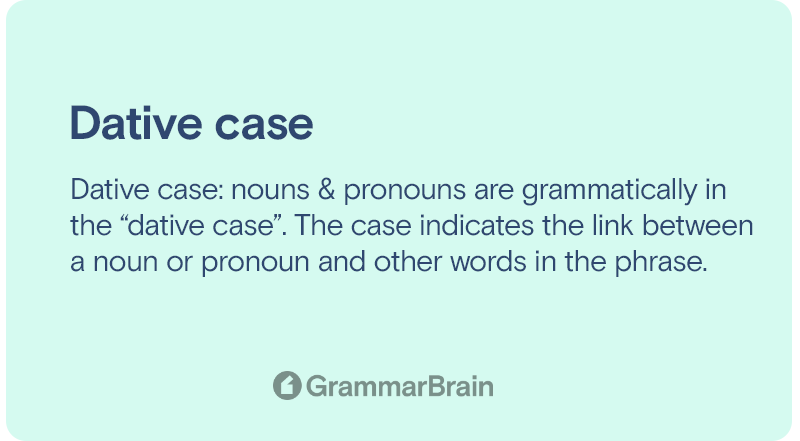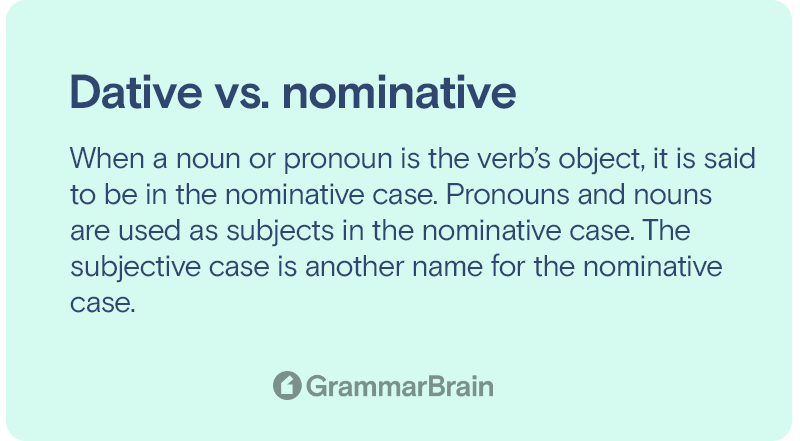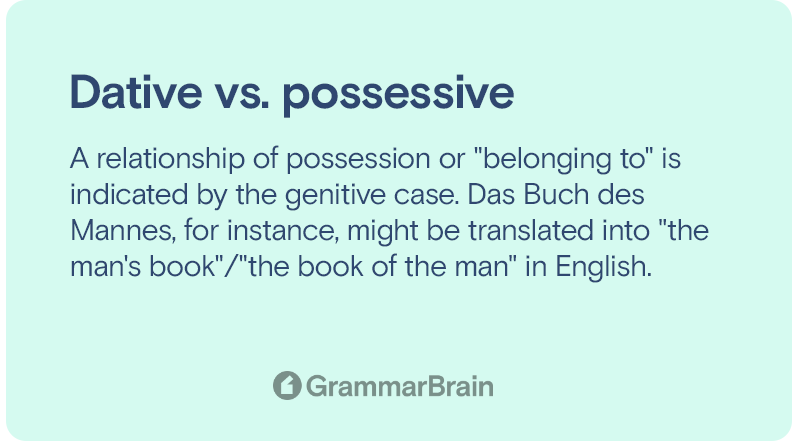What is the dative case? How does the dative case work? English’s “dative case” is a grammatical construction that shows an indirect object to a verb. Dative case can be challenging to comprehend. And to comprehend against the other case types. To get a comprehensive overview of dative case, continue reading.

What does “dative case” mean?
Dative case: nouns & pronouns are grammatically in the “dative case”. The case indicates the link between a noun or pronoun and other words in the phrase.
The “dative case” demonstrates how an indirect object relates to a verb.
| Case | Definition |
| Dative Case (plural dative cases) | Case used to express direction towards an indirect object, the recipient or beneficiary of an action, and is generally indicated in English by to (when a recipient) or for (when a beneficiary) with the objective case. (Wiktionary) |
The receiver of a direct object is an indirect object. The direct object is delivered to the indirect object.
Discover the verb, then ask “what?” to discover the ‘direct object’. After completing which, you can ask “for whom?” to determine ‘indirect object’.
Note: The accusative case will be used for the direct object. “Dative case” will be used for the indirect object.

Examples of “dative case”:
He gave the beggar a penny.
- Step 1: You need to discover the verb from the sentence: gave
- Step 2: The next question should be to ask, verb + ‘what?’: a penny
- Step 3: The next question to ask is ‘for whom?: (the receiver) = the beggar
You can conclude that the direct object here is a penny’. The direct object’s receiver is ‘the beggar.’ The words ‘the beggar’ are in the “dative case.” This was a simple sentence since nouns do not change form in a “dative case.”
She gave the son some food.
- Step 1: You need to discover the verb from the sentence: ‘gave’
- Step 2: The next question should be to ask, verb + ‘what?’: some food
- Step 3: The next question to ask is ‘for whom?: (the receiver) = the son
You can conclude that the direct object here is ‘some food.’ The direct object’s receiver is ‘the son. The ‘the son’ word is in the “dative case.” This was a simple sentence since nouns do not change form in a “dative case.”
She wrote a poem for him.
- Step 1: You need to discover the verb from the sentence: wrote
- Step 2: The next question should be to ask, verb + ‘what?’: a poem
- Step 3: The next question to ask is ‘for whom?: (the receiver) = him
You can conclude that the direct object here is ‘a poem.’ The direct object’s receiver is ‘him,’ a pronoun. The words’ him’ are in the “dative case.” This was a simple sentence since nouns don’t change form in a “dative case.”
He wrote the assignment for them.
- Step 1: You need to discover the verb from the sentence: wrote
- Step 2: The next question should be to ask, verb + ‘what?’: the assignment
- Step 3: The next question to ask is ‘for whom?: (the receiver) = them
You can conclude that the direct object here is ‘the assignment.’ The direct object’s receiver is ‘them.’ The words’ them’ are in the “dative case.” This was a simple sentence since nouns do not change form in a “dative case.”
Tom will send her the gift tomorrow.
- Step 1: You need to discover the verb from the sentence: will send
- Step 2: The next question should be to ask, verb + ‘what?’: the gift
- Step 3: The next question to ask is ‘for whom?: (the receiver) = her
You can conclude that the direct object here is ‘the gift. The direct object’s receiver is ‘her.’ The word ‘her’ is in the “dative case.” This was a simple sentence since nouns do not change form in a “dative case.”
Dative case vs. nominative case
When a noun or pronoun is the verb’s object, it is said to be in the nominative case. Pronouns and nouns are used as subjects in the nominative case. The subjective case is another name for the nominative case.
The case used for a pronoun or noun that is an indirect object is known as the “dative case.” Pronouns & nouns are used as objects in dative sentences. You can use ‘subjective case’ interchangeably with ‘nominative case.’
Take note of the variations in the sentences below. The subjects and indirect objects alter depending on whether they are used in the nominative or “dative case.”
He gave her a chocolate.
- Subject is the nominative case: he
- Direct object: a chocolate
- Verb: gave
- Indirect object in “dative case”: her
Dative case vs. accusative case
The “dative case” is an object subject to the impact of the verb in an indirect or incidental way. In contrast, the accusative is the direct object which gets the direct impact of the verb’s action.

Dative case vs. genitive case
A relationship of possession or “belonging to” is indicated by the genitive case. Das Buch des Mannes, for instance, might be translated into “the man’s book”/”the book of the man” in English.
The indirect object of sentences and several prepositions are written in the “dative case” (prepositions are covered in Unit 5). Review the English definition of “indirect object” first.
For instance, “The woman (subject) hands the book (direct object) to the man (indirect object).”
Here, it is clear that English determines which noun is the direct or indirect object based on the arrangement of those two nouns.
When the “dative case” is the Objective Case
The “dative case” and the accusative case are objective cases in English. Let’s revisit the earlier example:
Tom will send her the gift tomorrow.
- Step 1: You need to discover the verb from the sentence: will send
- Step 2: The next question should be to ask, verb + ‘what?’: the gift (It is a direct object. The accusative case, which is the objective case in English, indicates the direct object.)
- Step 3: The next question to ask is ‘for whom?: (the receiver) = he (It is an indirect object here. The “dative case”, which is also the objective case in English, serves to indicate the indirect object.)
Remember that English nouns do not alter in the so-called “oblique” situations. Our pronouns, however, do.
Because of this, “the presentation” has remained unchanged, and “he” has changed to “he.”
How can prepositions take the “dative case”?
Prepositions that take the “dative case” are something you could run into, especially when learning different languages. For instance, the German words “aus,” “bei,” “mit,” “nach,” “seit,” “von,” and “zu” are in the “dative case.”
For example:
- With him (and not with he)
- With whom (not with who)
Is the “dative case” important?
Yes, learning the “dative case” is important for the following reasons.
Learning any new language:
To learn a new language, you must master the oblique cases swiftly. You must understand how pronouns, adjectives, nouns, and determiners alter to represent the various situations if you want to advance.
Correctly using the word ‘whom’:
The only major problem with “dative case” for native English speakers is utilizing “who” as the ‘object’ (i.e., an indirect object, a direct object, or a prepositional object). When referring to an object, use “whom.”
FAQs
Can prepositions take the “dative case”?
The “dative case” pronouns & nouns are frequently the subjects of a preposition. The pronoun or the noun a preposition is attached to is the prepositional object.
Can you identify a “dative case” in the sentence?
In both German and English, the “dative case” describes the indirect object of a phrase and provides a “were” or “wem” response (what). For indirect objects, which typically get an action from the direct object, we typically employ the “dative case” (in the accusative case).
Where did the word ‘“dative case”’ originate?
The Latin adjective datus is where the term “dative” originates. This, in turn, is created from the verb “give” in Greek.
What are masculine and neuter nouns?
With masculine and neuter nouns, you can identify the dative case by the letters у and ю. Those words are the dative form of the masculine nouns.
Inside this article
Fact checked:
Content is rigorously reviewed by a team of qualified and experienced fact checkers. Fact checkers review articles for factual accuracy, relevance, and timeliness. Learn more.
Core lessons
Glossary
- Abstract Noun
- Accusative Case
- Anecdote
- Antonym
- Active Sentence
- Adverb
- Adjective
- Allegory
- Alliteration
- Adjective Clause
- Adjective Phrase
- Ampersand
- Anastrophe
- Adverbial Clause
- Appositive Phrase
- Clause
- Compound Adjective
- Complex Sentence
- Compound Words
- Compound Predicate
- Common Noun
- Comparative Adjective
- Comparative and Superlative
- Compound Noun
- Compound Subject
- Compound Sentence
- Copular Verb
- Collective Noun
- Colloquialism
- Conciseness
- Consonance
- Conditional
- Concrete Noun
- Conjunction
- Conjugation
- Conditional Sentence
- Comma Splice
- Correlative Conjunction
- Coordinating Conjunction
- Coordinate Adjective
- Cumulative Adjective
- Dative Case
- Determiner
- Declarative Sentence
- Declarative Statement
- Direct Object Pronoun
- Direct Object
- Diction
- Diphthong
- Dangling Modifier
- Demonstrative Pronoun
- Demonstrative Adjective
- Direct Characterization
- Definite Article
- Doublespeak
- False Dilemma Fallacy
- Future Perfect Progressive
- Future Simple
- Future Perfect Continuous
- Future Perfect
- First Conditional
- Irregular Adjective
- Irregular Verb
- Imperative Sentence
- Indefinite Article
- Intransitive Verb
- Introductory Phrase
- Indefinite Pronoun
- Indirect Characterization
- Interrogative Sentence
- Intensive Pronoun
- Inanimate Object
- Indefinite Tense
- Infinitive Phrase
- Interjection
- Intensifier
- Infinitive
- Indicative Mood
- Participle
- Parallelism
- Prepositional Phrase
- Past Simple Tense
- Past Continuous Tense
- Past Perfect Tense
- Past Progressive Tense
- Present Simple Tense
- Present Perfect Tense
- Personal Pronoun
- Personification
- Persuasive Writing
- Parallel Structure
- Phrasal Verb
- Predicate Adjective
- Predicate Nominative
- Phonetic Language
- Plural Noun
- Punctuation
- Punctuation Marks
- Preposition
- Preposition of Place
- Parts of Speech
- Possessive Adjective
- Possessive Determiner
- Possessive Case
- Possessive Noun
- Proper Adjective
- Proper Noun
- Present Participle
- Prefix
- Predicate



